Loblaws decided last January to stop 50% sales on ugly fruits and vegetables and almost expired products. Faced with popular discontent, the food giant decided to reverse its decision.
Obviously, Loblaws initially justified this decision by explaining that all the banners on the market offered a maximum of 30% on these products. In the absence of real competition in the Canadian market, no grocer has any interest in offering a more competitive price than the other. In economics, we call this an oligopoly.
That Loblaws and IGA were involved in the bread cartel from 2001 to 2021 is not surprising. For 20 years, Canadian companies artificially inflated prices in order to illegally pocket more than $5 billion.
- Listen to Francis Gosselin’s editorial via QUB :
Fewer and fewer discounted products
There are products at 50% off at Loblaws, and 30% elsewhere, because everywhere, grocers order too many products compared to what is actually consumed. It is difficult to know precisely, to the nearest unit, how many breads, tomatoes and muffins will be sold to 9 million Quebecers every day or every week. Weather, preferences, advertising and chance can vary demand.
We therefore sell these products on sale, because it is better than throwing them away. But grocers have a plan.
Through their loyalty programs, grocery giants now know every item you purchased, where and at what time. This allows them to better predict what you will buy. It is obvious that one of the objectives of these programs is to reduce the number of unsold products, and therefore products on sale.
Through our voluntary participation in loyalty programs, we participate in the gradual disappearance of products on sale. The more Quebecers take advantage of the small points offered to them by grocery giants, the fewer products there will be at a discount.
Amazing profits and bonuses
To justify themselves, the bosses of the major chains and a few academics in their pay hastened to explain to us that the margins have remained practically constant.
Let’s imagine a scenario: you invest $100 to sell charms for $1. Inflation is coming and now your charm is worth $2. The margins remain the same, but you make twice as much profit. Did you take a bigger risk? No. Are you working harder? No.
- Listen to Francis Gosselin’s editorial via QUB :
You are exploiting a captive market to extract more profits, without any merit.
Since 2020, Loblaws’ shares have increased by 100%, Metro’s by 44%. Are we to believe that these meteoric increases in profitability, dividends, bonuses and executive compensation are the results of their incredibly intelligent work?
Grocery giants are exploiting an oligopoly situation to extract more and more money from consumers, and in doing so, concentrate even more of that wealth in their coffers. It’s high time that changed.

